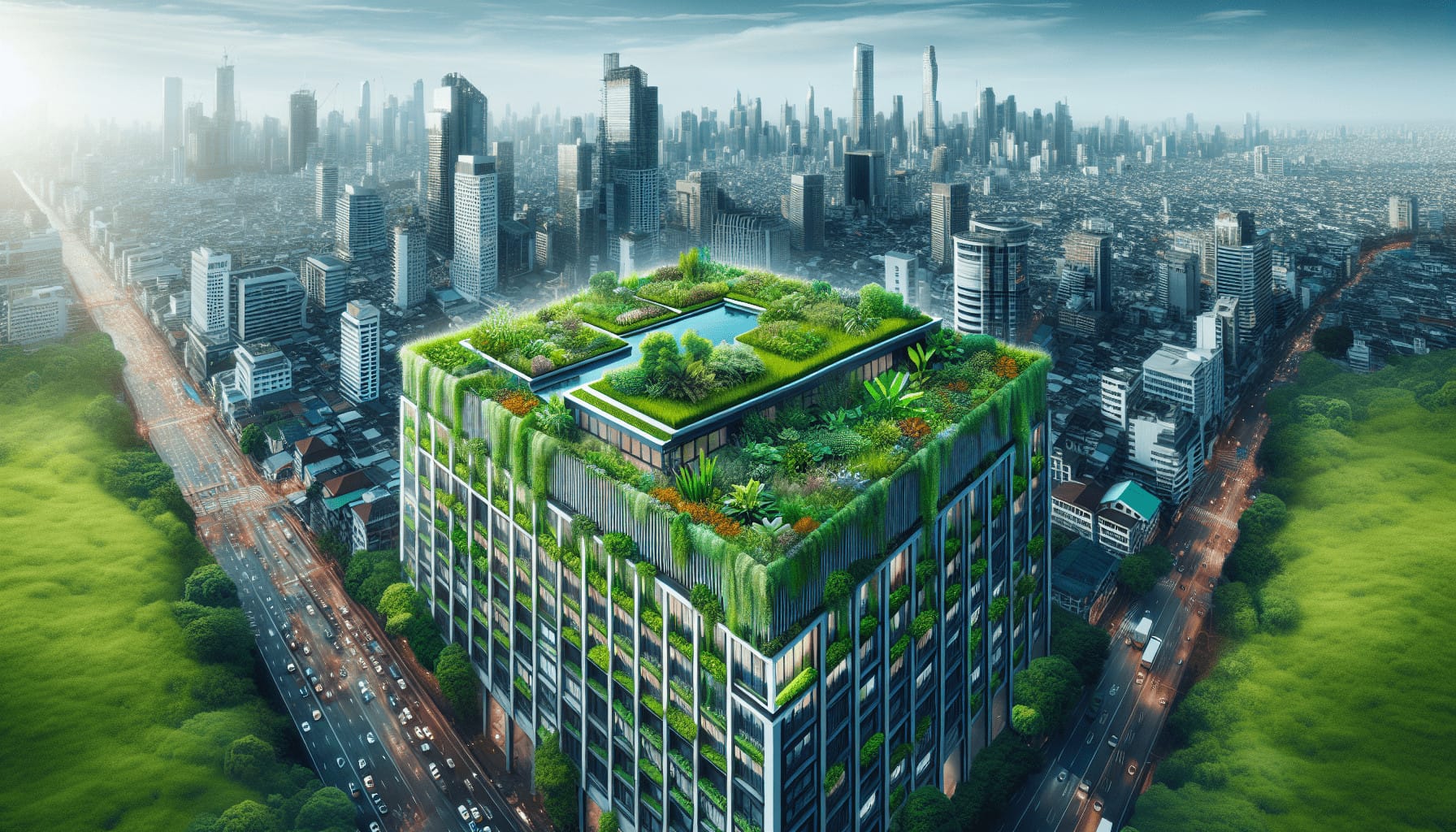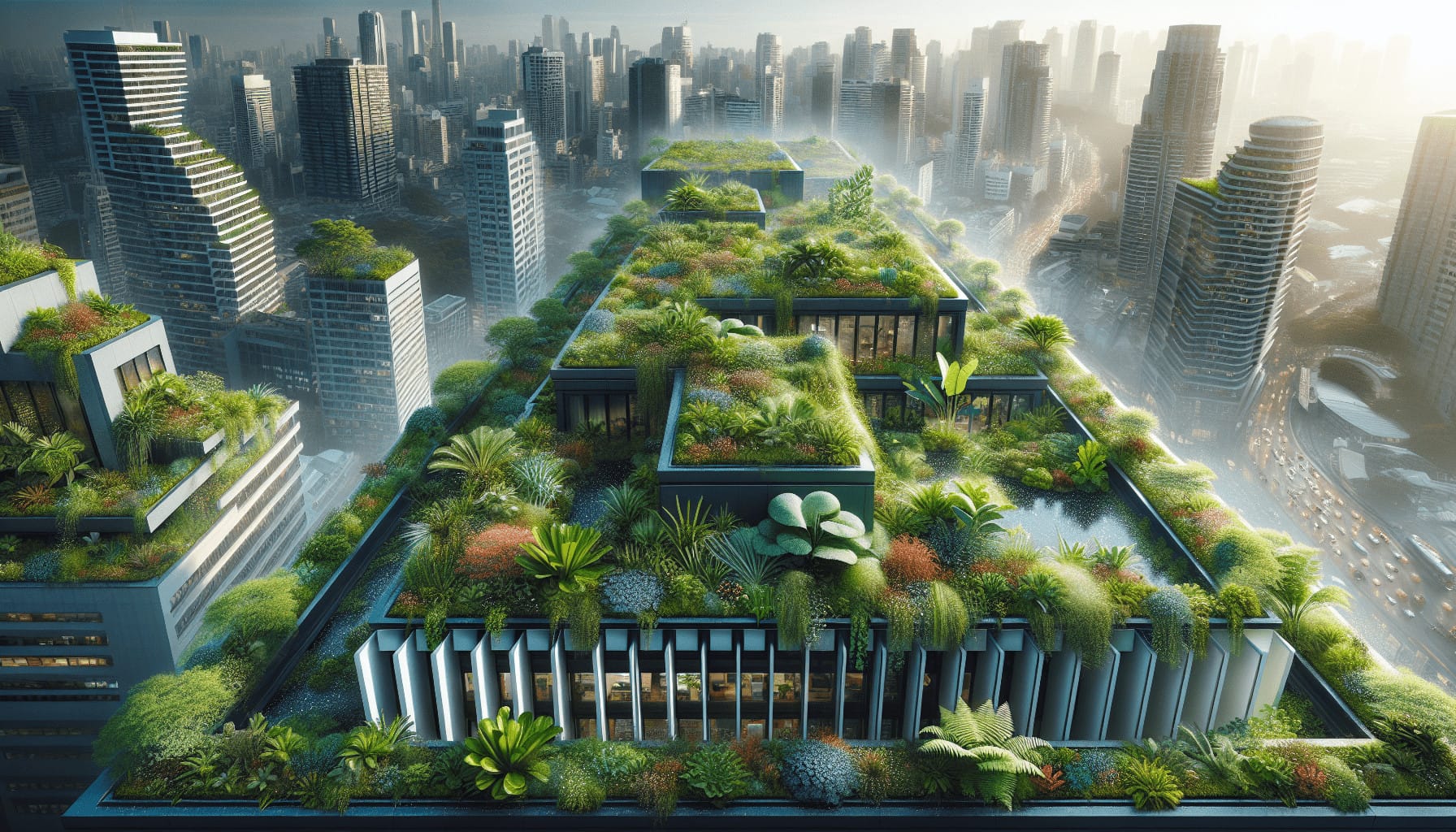Have you ever looked up at a city skyline and noticed a patch of greenery amidst the ocean of concrete? You might have glimpsed the future of urban landscapes—a green roof. These verdant spaces atop buildings are not just aesthetic additions; they play a crucial role in our battle against climate change. Let’s dive into how green roof systems serve as essential tools in adapting to climate fluctuations and environmental challenges.

Understanding Green Roof Systems
Green roofs, sometimes known as living roofs, are layers of vegetation planted over a waterproofing system that is installed on flat or slightly–sloped roofing. They come in various types, including extensive, intensive, and semi-intensive, each catering to different building needs and environmental goals.
Types of Green Roof Systems
Understanding the types of green roofs can help you appreciate their distinct characteristics and functionalities within urban ecosystems.
Extensive Green Roofs: Light and low-maintenance, these are the most common types of green roofs. They typically feature drought-resistant plants and require a minimum soil depth. They’re ideal for rooftops that cannot support much weight.
Intensive Green Roofs: These roofs resemble traditional gardens or parks, featuring a variety of plants, including shrubs and small trees. They require deeper soil, more maintenance, and a stronger structural support due to their weight.
Semi-Intensive Green Roofs: These combine characteristics of both extensive and intensive systems, offering more diversity of plant species while requiring moderate maintenance.
Environmental Benefits of Green Roofs
Implementing green roof systems comes with a myriad of environmental benefits that aid significantly in climate change adaptation.
Temperature Regulation
Green roofs help mitigate the urban heat island effect, where urban or metropolitan areas become significantly warmer than their rural surroundings. The vegetation on these roofs absorbs sunlight and utilizes it for photosynthesis, thus lowering the surrounding temperatures and enhancing urban comfort levels.
Stormwater Management
One of the pressing issues in urban areas is stormwater runoff, leading to flooding and water pollution. Green roofs absorb rainwater, which reduces the volume and rate of runoff. Plants and soil act as natural filters, improving water quality before it reaches the stormwater systems.
Air Quality Improvement
Plants are natural air purifiers. By trapping dust and absorbing carbon dioxide, green roofs contribute to cleaner air. They help reduce urban pollution, providing a healthier environment for city dwellers.
Biodiversity Support
Green roofs can serve as miniature ecosystems, providing habitats for various plant species, birds, and insects. They help maintain biodiversity in urban settings, offering refuge to species that may struggle to thrive elsewhere in the city.
Green Roof Systems in Urban Infrastructure
Incorporating green roofs into urban planning goes beyond environmental benefits; it integrates into the very fabric of city life, influencing both the physical and socio-economic environment.
Aesthetic and Recreational Spaces
Green rooftops transform urban environments by adding vibrant, natural spaces that are both visually appealing and functional. They create recreational and community spaces for city residents, offering areas for relaxation, peace, and even farming in urban agriculture projects.
Energy Efficiency
By insulating buildings, green roofs help in reducing energy costs associated with heating and cooling. During hot months, they minimize the need for air conditioning by cooling the building’s interior, while in colder months, the additional layer aids in heat retention.
Property Value Increase
The aesthetic and functional benefits of green roofs can enhance property values. By improving building attractiveness and environmental credentials, properties featuring green roofs often see a rise in market value and appeal.
Challenges and Considerations
While green roofs bring a plethora of benefits, they also pose certain challenges and require careful consideration in their implementation and maintenance.
Structural Requirements
The weight of a fully saturated green roof needs to be supported by the building’s structure, necessitating thorough assessment and potential reinforcement. The architectural integrity and design must suit the green roof’s demands to ensure safety and longevity.
Maintenance
Depending on the type of green roof system, maintenance can range from minimal for extensive roofs to regular and intensive for intensive roofs. Tasks like watering, weeding, and structural inspections demand resources and commitment.
Cost Concerns
Initial installation costs can be substantial, including waterproofing membranes, drainage, and soil layers. However, these costs are often offset over time by the energy savings and increased property values.

Technological Innovations in Green Roof Systems
Advancements in technology are constantly enhancing the effectiveness and appeal of green roofs, making them viable options for more buildings.
Smart Irrigation Systems
The integration of technology through sensors and automated irrigation systems can significantly reduce water usage and ensure optimal plant health, particularly in areas with variable rainfall.
Lightweight Materials
Innovations in materials have led to the development of lightweight substrates that reduce the overall weight of green roofs, expanding opportunities for a wider range of buildings to support them.
Modular Roof Systems
Pre-fabricated modular systems make installation more accessible and scalable, allowing for easier maintenance and a quicker deployment of green rooftops.
Climate-Resilient Plant Species
Through research and development, climate-resilient plant species are being cultivated to withstand extreme weather conditions and require less maintenance, thus enhancing the durability of green roofs.
Future of Green Roof Systems
As urbanization continues to accelerate, the role of green roofs is expected to expand and evolve, driven by both necessity and innovation.
Policy and Legislation
Governments and city planners are beginning to recognize the benefits of green roofs, influencing policy and regulations that encourage or mandate their inclusion in new developments.
| City | Green Roof Policy |
|---|---|
| Toronto | Mandatory for new buildings of a certain size |
| New York City | Incentives for green roof installations |
| Paris | Requires rooftops to be green or solar |
Integration with Renewable Energy
Combining green roofs with solar panels or wind generators could significantly boost building sustainability. This hybrid approach maximizes the utility of rooftop spaces, contributing further to energy efficiency and resource management.
Community and Educational Roles
Green roofs have the potential to serve educational purposes, offering urban residents, particularly students, unique learning opportunities about ecology, sustainability, and urban agriculture.
How You Can Be Involved
Whether you’re a resident, a business owner, or a city planner, there’s a role you can play in advocating for and implementing green roof systems.
Home Installations
If you’re a homeowner, consider installing a green roof on your personal property. Look into available incentives and consult with professionals to assess feasibility.
Advocacy and Awareness
Raising awareness about the benefits of green roofs within your community can help foster a culture that values and supports sustainable building practices. Advocate for policies that promote the adoption of green roofs in urban areas.
Participation in Community Projects
Engage with local initiatives and community projects focused on green roofing or urban greening efforts. Participating in such projects not only contributes to environmental improvement but also strengthens community ties.
Conclusion
Green roof systems offer multifaceted benefits that extend beyond immediate environmental gains to broader socio-economic advantages. They represent a pivotal step towards sustainable urban development and climate resilience. By understanding their value and championing their integration in urban landscapes, you contribute to a healthier, more sustainable future. Who knew that the secret to a cooler, cleaner, and more vibrant city might just lie overhead, cushioned in a layer of lush greenery?
